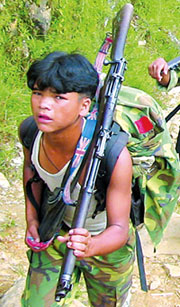. Three days later, ten-year-old Anil KC of Banki VDC in Dang was playing with a round metal object near his home when it exploded. Anil is now recovering from severe wounds at a hospital in Ghorahi.
. The Maoists left four pipe bombs on a bridge along the Rangeli-Biratnagar highway. One of them exploded on 3 February injuring 10 people including eight-year-old Manoj Mahato who has deep cuts in both legs.
All three incidents took place in one week and became the latest in the grim statistics of children killed and maimed in the last ten years of war. And these are just the physically wounded, there is no estimate of the number of children who bear psychological and mental trauma.
Schools have been turned into war zones. The Maoists have used playgrounds for drills and marchpasts, forced students to dig bunkers and trenches. The army has converted some schools into barracks and used playing fields as helipads. In addition, the Maoists have systematically targetted the country's education system, closing down schools, forcing students to attend propaganda meetings, and using them as recruiting centers.
|
|
The estimates of children directly and indirectly affected by the conflict in the past 10 years is approximate. Besides those directly hurt, there are hundreds of thousands who have been orphaned or had family members killed or disappeared, been deprived of education, been force-marched for days to re-education camps or coerced into joining the rebel ranks.
Many children are forced to associate with armed forces and armed groups as militia, porters, kitchen helpers, spies and informants or messengers. In addition, the Maoists forcefully recruited children through 'People's Education Trainings'.
"On an average 41 children have died every year in the past ten years," says Tarak Dhital of the child welfare group, CWIN, "in addition there are severe psycho-social effects that we haven't even begun to estimate." A total of 424 children have been killed in the past ten years, but these are only deaths reported to CWIN there may hundreds of more unreported fatalities. Nearly half of all children in Nepal are now directly affected by conflict because of recruitment or schools being closed, according to CWIN.
Ceasefires have been good for children. In the four months before the ceasefire, (May-August 2005) 25 children were killed, while six were killed during the ceasefire. However, 3,232 children were force marched to attend re-education during the ceasefire.



